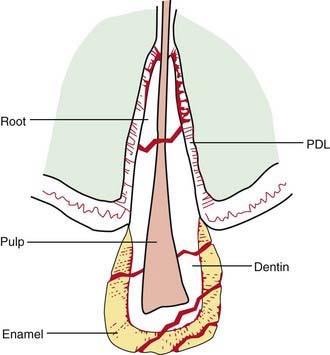Chapter 306 Dental Trauma
Injuries to Teeth
Approximately 10% of children between 18 mo and 18 yr of age sustain significant tooth trauma. There appear to be 3 age periods of greatest predilection: toddlers (1-3 yr), usually due to falls or child abuse; school-aged children (7-10 yr), usually from bicycle and playground accidents; and adolescents (16-18 yr), often the result of fights, athletic injuries, and automobile accidents. Injuries to teeth are more common among children with protruding front teeth. Children with craniofacial abnormalities or neuromuscular deficits are also at increased risk for dental injury. Injuries to teeth can involve the hard dental tissues, the dental pulp (nerve), and injuries to the periodontal structure (surrounding bone and attachment apparatus) (Fig. 306-1 and Table 306-1).
Table 306-1 INJURIES TO CROWNS OF TEETH
| TYPE OF TRAUMA | DESCRIPTION | TREATMENT AND REFERRAL |
|---|---|---|
| Enamel infraction (crazing) | Incomplete fracture of enamel without loss of tooth structure | Initially might not require therapy but should be assessed periodically by dentist |
| Enamel fractures | Fracture of only the tooth enamel | Tooth may be smoothed or treated to replace fragment |
| Enamel and dentin fracture | Fracture of enamel and dentinal layer of the tooth. Tooth may be sensitive to cold or air. Pulp may become necrotic, leading to periapical abscess. | Refer as soon as possible. Area should be treated to preserve the integrity of the underlying pulp. |
| Enamel, dentin fracture involving the pulp | Bacterial contamination can lead to pulpal necrosis and periapical abscess. The tooth might have the appearance of bleeding or might display a small red spot. | Refer immediately. The dental therapy of choice depends on the extent of injury, the condition of the pulp, the development of the tooth, time elapsed from injury, and any other injuries to the supporting structures. Therapy is directed toward minimizing contamination in an effort to improve the prognosis. |
From Josell SD, Abrams RG: Managing common dental problems and emergencies, Pediatr Clin North Am
Stay updated, free articles. Join our Telegram channel

Full access? Get Clinical Tree



